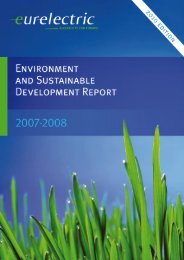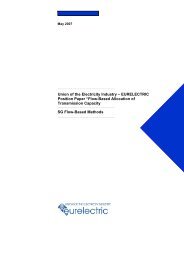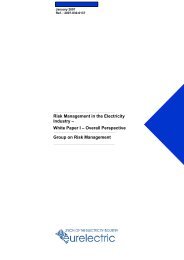Hydro in Europe: Powering Renewables - Full Report - Eurelectric
Hydro in Europe: Powering Renewables - Full Report - Eurelectric
Hydro in Europe: Powering Renewables - Full Report - Eurelectric
You also want an ePaper? Increase the reach of your titles
YUMPU automatically turns print PDFs into web optimized ePapers that Google loves.
There are two types of storage hydropower plants:<br />
a) hydropower plants with a storage reservoir; and<br />
b) pumped storage hydropower plants.<br />
The larger the reservoir of a hydropower plant, the more storage it can provide.<br />
Conventional reservoir-type hydropower plants generally have a more significant<br />
storage capacity <strong>in</strong> terms of volume than pumped storage plants. Pumped storage<br />
plants are used for short-term activities (with<strong>in</strong> a day or week) and can adapt to<br />
electricity system needs very quickly. Larger conventional reservoirs are used for longterm<br />
storage but have <strong>in</strong> most cases also capacity to participate <strong>in</strong> short-term<br />
activities.<br />
a) hydropower plants with a storage reservoir<br />
Reservoir-type hydropower plants <strong>in</strong>volve impound<strong>in</strong>g water beh<strong>in</strong>d a dam. This<br />
enables flow regulation throughout a season or the year. <strong>Hydro</strong>power plants with large<br />
reservoirs can provide flow regulation even on a multi-annual basis. Large reservoirs<br />
not only provide an energy reserve to satisfy electricity demand dur<strong>in</strong>g dry seasons<br />
and/or periods of peak demand, but they also allow the reta<strong>in</strong><strong>in</strong>g of more water.<br />
Reservoir-type hydropower plants are typically used for highly variable flows <strong>in</strong> the<br />
middle reaches of a river, or as energy storage <strong>in</strong> the upper reaches of a river.<br />
Reservoir-type hydropower plants on gorge or canyon systems also deliver high<br />
capacity.<br />
Pictures 3 and 4 show examples of reservoir-type hydropower plants.<br />
Picture 3 Orellana – a reservoir plant <strong>in</strong> Spa<strong>in</strong><br />
Source:<br />
27<br />
Picture 4 Blåsjø reservoir of the Ulla-Førre<br />
hydropower scheme <strong>in</strong> Western Norway<br />
Source: Statkraft 2011<br />
The generat<strong>in</strong>g stations of reservoir-type hydropower plants are usually located at the<br />
dam toe, although they can sometimes be found further downstream. In the latter<br />
case the power plant is often connected to the reservoir by tunnels or penstocks (gates<br />
for water).

















